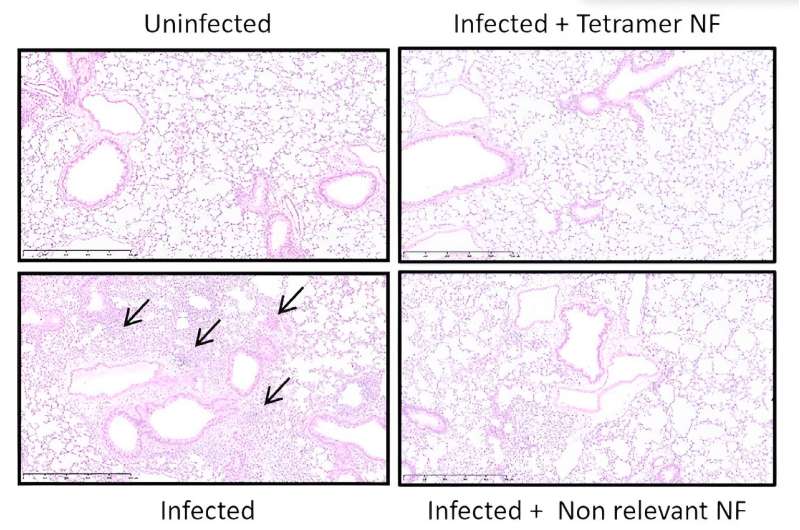This article has been reviewed according to Science X's editorial process and policies. Editors have highlighted the following attributes while ensuring the content's credibility:
fact-checked
peer-reviewed publication
trusted source
proofread
Inhalable molecules neutralize SARS-CoV-2 in mice

Nanofitins, which are derived from a protein found in Sulfolobus acidocaldarius—an archaeal microorganism found in hot springs—successfully neutralized SARS-CoV-2 in mice and were well-tolerated. When inhaled by the rodents, the engineered nanofitins, which inhibit the virus by binding to its spike proteins, were observed to quickly reach the lungs in high doses both preventing and clearing early infections, researchers from biotech company Affilogic report Aug. 30 in the journal Molecular Therapy.
"We were able to generate, in few months, anti-SARS-CoV-2 nanofitins inhibiting the viral infection and then genetically fuse them together into a single powerful molecule that could simultaneously block several regions of the virus for enhanced efficacy," says first author Sébastien Viollet, an R&D project manager at Affilogic. "Classical methods mostly rely on neutralizing a single region of viruses to inhibit their infection. We went beyond this as a means to potentially maintain the blockade efficiency even if one of the regions is mutated."
Previous treatments for COVID-19 such as monoclonal antibodies were limited by the need for high doses, delays in reaching therapeutic concentrations at the site of infection, and decreased therapeutic efficacy against new SARS-CoV-2 variants.
If approved for use in humans, nanofitin technology could offer a noninvasive alternative with immediate inhibition of viral load present in the lung tissues. Because the molecules are relatively small and very thermostable, their resistance to high temperatures and a wide range of pH values could help streamline manufacturing and formulation.
"The nanofitin technology is very adaptive and could be implemented in other infectious respiratory diseases, increasing the number of biologics administered directly into the lung for fast action and ease of use," Viollet says. "This is of particular interest for populations with limited tolerance to repeated injections, such as infants and elderly people. The cost of such inhaled products is also expected to be lower than current injectables, and they require fewer constraints such as temperature control, therefore achieving higher global accessibility."
The authors say more work will be needed to achieve cross-reactivity against a broad spectrum of variants while maintaining a speedy development process. In addition, a new efficacy study should be performed to evaluate nanofitins in comparison to other biologics in the same setup, for instance after injection.
More information: Inhalable nanofitin demonstrates high neutralization of SARS-CoV-2 virus via direct application in respiratory tract, Molecular Therapy (2023). DOI: 10.1016/j.ymthe.2023.08.010
Journal information: Molecular Therapy
Provided by Cell Press





















